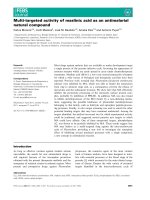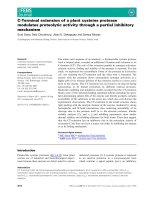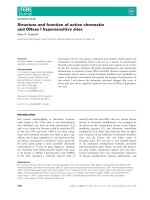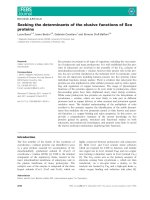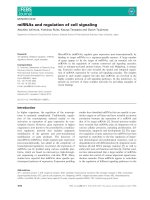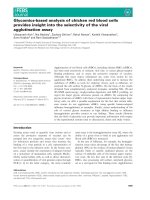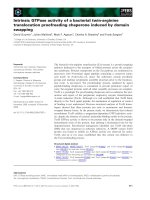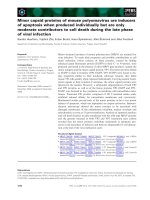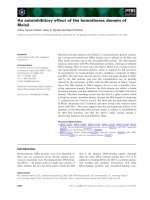Tài liệu Báo cáo khóa học: Tungsten-containing aldehyde oxidoreductase of Eubacterium acidaminophilum ppt
Bạn đang xem bản rút gọn của tài liệu. Xem và tải ngay bản đầy đủ của tài liệu tại đây (183.21 KB, 8 trang )
Tungsten-containing aldehyde oxidoreductase of
Eubacterium
acidaminophilum
Isolation, characterization and molecular analysis
David Rauh, Andrea Graentzdoerffer, Katrin Granderath, Jan R. Andreesen and Andreas Pich*
Institut fu
¨
r Mikrobiologie, Martin-Luther-Universita
¨
t Halle-Wittenberg, Halle, Germany
Aldehyde oxidoreductase of Eubacterium acidaminophilum
was purified to homogeneity under strict anaerobic condi-
tions using a four-step procedure. The purified enzyme was
present as a monomer with an apparent molecular mass of
67 kDa and contained 6.0 ± 0.1 iron, 1.1 ± 0.2 tungsten,
about 0.6 mol pterin cofactor and zinc, but no molybdenum.
The enzyme activity was induced if a molar excess of electron
donors, such as serine and/or formate, were supplied in the
growth medium compared to readily available electron
acceptors such as glycine betaine. Many aldehydes served as
good substrates, thus enzyme activity obtained with acetal-
dehyde, propionaldehyde, butyraldehyde, isovaleraldehyde
and benzaldehyde differed by a factor of less than two.
Kinetic parameters were determined for all substrates tested.
Oligonucleotides deduced from the N-terminal amino acid
sequence were used to isolate the encoding aorA gene and
adjacent DNA regions. The deduced amino acid sequence of
the aldehyde oxidoreductase exhibited high similarities to
other tungsten-containing aldehyde oxidoreductases from
archaea. Transcription of the aorA gene was monocistronic
and started from a r
54
-dependent promoter. Upstream of
aorA, the gene aorR is localized whose product is similar to
r
54
-dependent transcriptional activator proteins and, thus,
AorR is probably involved in the regulation of aorA
expression.
Keywords: aldehyde oxidoreductase; tungsten; pyranopterin
cofactor; transcriptional regulation; Eubacterium acidamino-
philum.
Tungsten is a rather rare element [1] and the element with
the largest mass positively involved in living systems. In
recent years, tungsten-containing enzymes have been puri-
fied from a wide variety of microorganisms [2–6]. The
tungsten-containing aldehyde oxidoreductases (AOR) rep-
resent a family within the group of pyranopterin-containing
molybdo- and tungstoenzymes. In contrast to enzymes of
the dimethyl sulfoxide family, tungsten is always at the
enzymatic active site ligated by two pyranopterin cofactors
andanoxogroupintheenzymesoftheAORfamily[4].
These features separate the enzymes of the AOR family
from those of the aldehyde oxidase-type belonging
to the xanthine oxidase (molybdenum hydroxylase) family
(containing molybdenum ligated to just one pyranopterin-
cofactor and a characteristic sulfido group) as observed for
aldehyde oxidase and from sulfate reducers like Desulfovib-
rio gigas or milk xanthine oxidase [7]. The tungsten-
containing AOR family is subdivided into aldehyde
oxidoreductase/aldehyde dehydrogenase (AOR) [8–13],
formaldehyde oxidoreductase (FOR) [14,15], glyceralde-
hyde-3-phosphate oxidoreductase (GAPOR) [16] and carb-
oxylic acid reductase (CAR) [17,18]. These enzymes have
mainly been isolated from hyperthermophilic archaea like
Pyrococcus furiosus or Thermococcus litoralis and from
acetogenic bacteria like Moorella thermoacetica and Clos-
tridium formicoaceticum. P. furiosus contains additional
tungsten-containing enzymes with high similarities to
AOR. Despite these similarities, the purified protein
WOR4 exhibited none of the known enzymatic activities
with aldehydes [19]. Evident from crystallographic studies of
aldehyde oxidoreductase from P. furiosus, tungsten is
coordinated by two cis-enedithiolate groups of two moly-
bdopterin cofactors [11,15,20]. Besides tungsten, all of these
aldehyde oxidoreductases possess also one [4Fe-4S] cluster
whichisinvolvedinelectrontransferfromthetungsten-binding
pterincofactortoanelectronacceptor,usuallyferredoxin.
The anaerobic Gram-positive bacterium Eubacterium
acidaminophilum degrades amino acids by Stickland reac-
tions [21] and possesses two tungsten-containing formate
dehydrogenases that are highly similar in their biochemical
characteristics and share more than 65% identity in their
primary sequence [6,22]. Formate dehydrogenase-I was
partially purified, whereas formate dehydrogenase-II was
purified to homogeneity. Tungsten and iron, but no
molybdenum, were found in the final fractions of both
enzymes. The presence of a tungsten-dependent aldehyde
oxidoreductase activity was induced by high concentrations
Correspondence to J. R. Andreesen, Institut fu
¨
r Mikrobiologie,
Kurt-Mothes-Str. 3, 06120 Halle, Germany.
Fax: + 49 345 5527010, Tel.: + 49 345 5526350,
E-mail:
Abbreviations: AOR, aldehyde oxidoreductase; FOR, formaldehyde
oxidoreductase; GAPOR, glyceraldehyde-3-phosphate
oxidoreductase.
*Present address: Institut fu
¨
r Pathologie, MH-Hannover,
Carl-Neuberg-Str. 1, 30625 Hannover, Germany.
Note: The nucleotide sequence data reported here are available in the
GenBank database under accession no. AJ318790.
(Received 20 August 2003, revised 29 October 2003,
accepted 12 November 2003)
Eur. J. Biochem. 271, 212–219 (2004) Ó FEBS 2003 doi:10.1046/j.1432-1033.2003.03922.x
of serine and formate, potential electron donors [22]. To
enable a specific incorporation of tungsten into these
enzymes, tungstate is bound very specifically by an extra-
cytoplasmic-orientated binding protein TupA, part of an
ABC transporter system [23], and a small cytoplasmic Mop
protein, of the molbindin family, able to bind tungstate and
molybdate [24].
In this paper we describe the isolation and biochemical
characterization of the aldehyde oxidoreductase from
Eubacterium acidaminophilum as a monomeric iron-sulfur
cluster containing tungstoenzyme. The AOR encoding gene
aorA and its adjacent DNA regions were cloned and
sequenced. Due to the similarity of aorR to a putative
regulator, the transcription of aorA and aorR was analyzed.
Materials and methods
Bacterial strains, phages and plasmids
E. acidaminophilum DSM 3953
T
was grown anaerobically in
a 100 L fermenter in a serine/formate medium (40/30 m
M
)
as described previously [21]. Other substrate combinations
used are indicated under Results. Escherichia coli XL1 blue
MRF¢ was used for DNA manipulations and as phage host
for Lambda ZAPII, M13 ExAssist helper phage and E. coli
SolR for in vivo excision (all Stratagene, Heidelberg,
Germany). The E. coli strains were cultivated aerobically
at 37 °C in Luria–Bertani broth [25]. If required, ampicillin
was added to the medium at a concentration of
125 lgÆmL
)1
, tetracycline at 12.5 lgÆmL
)1
, isopropyl thio-
b-
D
-thiogalactopyranoside at 40 lgÆmL
)1
and 5-bromo-
4-chloro-3-indolyl b-
D
-galactopyranoside at 48 lgÆmL
)1
.
For cloning purposes, plasmid pBluescript II SK/KS
(Stratagene) was used.
Enzyme assay
Aldehyde oxidoreductase was measured by a standard
procedure [17] at 34 °C under anaerobic conditions by
monitoring the acetaldehyde-dependent reduction of benzyl
viologen at 578 nm (e ¼ 8.3 m
M
)1
Æcm
)1
). The reaction
mixture contained 50 m
M
Tris buffer (pH 8.5), 20 m
M
benzyl viologen, 0.5 m
M
acetaldehyde and 0.1–10 lLof
enzyme. Sodium dithionite (1–5 lL; 50 m
M
) was added to
the reaction mixture to obtain an extinction of 0.2–0.3,
indicating strict anaerobic conditions. Blanks were per-
formed first by excluding the substrate, acetaldehyde, before
starting the reaction by the anaerobic addition of acetalde-
hyde. One unit of aldehyde oxidoreductase activity was
defined as the amount of enzyme catalyzing the reduction of
2 lmol of benzyl viologen per minute. For a fast check for
the presence of aldehyde oxidoreductase, the acetaldehyde-
dependent reduction of methylene blue was followed
visually in microtiter plates. The reaction mixture contained
0.2 m
M
methylene blue, 0.5 m
M
acetaldehyde and 50 m
M
Tris, pH 8.5. Enzyme solutions (1–10 lL) were added and
the decolorization of methylene blue was observed. Positive
reacting fractions were additionally analyzed by using the
benzyl viologen assay. The reverse reaction was analyzed
under strict anaerobic conditions in a reaction mixture
containing 300 m
M
potassium phosphate buffer (pH 6.0),
0.4 m
M
methyl viologen, 20 m
M
semicarbazide, 60 m
M
sodium acetate and up to 100 lLofenzyme.Methyl
viologen was reduced using sodium dithionite (50 m
M
)to
reach e
600
values around 1.0 (e ¼ 13.1 m
M
)1
Æcm
)1
). Subse-
quently, the reaction was started by adding enzyme.
Purification of aldehyde oxidoreductase
from
E. acidaminophilum
Extracts containing aldehyde oxidoreductase activity had to
be kept under strict anaerobic conditions. Due to the high
oxygen sensitivity of the enzyme, all buffers and solutions
were prepared by boiling for about 10 min and were flushed
with N
2
during cooling to room temperature and were
stored anaerobically. Buffer A contained 50 m
M
Tris/HCl,
pH 8.0, 2 m
M
sodium dithionite and 2 m
M
dithiothreitol.
Aldehyde oxidoreductase purification was performed in an
anaerobic chamber (Coy Laboratory Products, Michigan,
USA) containing an N
2
/H
2
(95/5%) atmosphere.
To obtain a crude extract, 13 g of frozen cells were
thawed and resuspended in 20 mL of buffer A. The
suspension was passed twice through a French pressure cell
(SLM Instruments Inc., Silver Spring, USA) at 140 MPa
(20 K cell). After centrifugation (30 min, 50 000 g)theclear
supernatant was taken as crude extract. A saturated
ammonium sulfate solution (in buffer A) was added to the
supernatant to obtain an overall saturation of 60%. The
mixture was stirred for 30 min and centrifuged at 20 000 g
for 15 min. The pellet was discarded, although it contained
a high portion of enzyme activity. The concentration of
ammonium sulfate in the supernatant was increased to
100% saturation. After another centrifugation, the pellet
was resuspended in buffer A, dialyzed against this buffer
and was applied to a Q-Sepharose column (20 mL)
previously equilibrated with buffer A. After loading of the
protein, the column was washed with 40 mL of buffer A,
and the proteins were eluted with a gradient from 0.1 to
0.6
M
NaCl in 300 mL buffer A. Aldehyde oxidoreductase
activity eluted from the column at about 0.3
M
NaCl.
Fractions containing aldehyde oxidoreductase activity were
collected, dialyzed against buffer A, and loaded onto a
MonoQ HR5/5 anion exchange column equilibrated with
buffer A and connected to an FPLC system (Amersham
Pharmacia). The column was washed with 10 mL buffer A
and proteins were eluted with an increasing NaCl gradient
(35 mL) from 0.2 to 0.8
M
in buffer A. Active fractions were
combined and concentrated to 200 lL using Microcon C30
concentrators (Amicon, Witten, Germany). The active
fraction was passed through a Superdex 200 gel filtration
column (Amersham Pharmacia) equilibrated with buffer A
containing 200 m
M
NaCl.
Protein and metal determination
Protein concentrations were determined by the Bradford
method using BSA as standard; SDS/PAGE was per-
formed with the Laemmli buffer system as described [6].
Proteins were blotted with a semidry blotter (Biometra,
Go
¨
ttingen, Germany) from an SDS gel onto a poly(vinyl-
dene difluoride) membrane in 50 m
M
Na
3
BO
3
buffer
(pH 9.0) containing 20% (v/v) methanol at 1.2 mAÆcm
)2
membrane for 1–2 h. Edman degradation was performed
with blotted protein in a 476 A amino acid sequencer
Ó FEBS 2003 Isolation and characterization of aldehyde oxidoreductase (Eur. J. Biochem. 271) 213
(Applied Biosystems, Weiterstadt, Germany), all as des-
cribed previously [6]. Metal content of aldehyde oxido-
reductase was determined using adsorptive stripping
voltammetry [26], and neutron activation [27]. Addition-
ally, the iron content was determined by a colorimetric
technique as described [28].
Analysis of pterin cofactor
The pterin cofactor content was determined as described
previously [29]. After oxidation of the cofactor with
potassium permanganate, protein was precipitated by the
addition of 2 vols of ice-cold ethanol and subsequent
centrifugation at 15 000 g for 15 min. The fluorescence of
the supernatant was determined. An emission spectrum was
obtained using an excitation wavelength of 380 nm and an
excitation spectrum was determined using an emission wave
length of 450 nm. Pterin-6-carboxylic acid was used as a
standard and a commercial available xanthine oxidase
(Serva) as positive reference.
DNA manipulations and DNA sequence determination
Genomic DNA from E. acidaminophilum was isolated as
decribed [6]. Plasmid DNA from E. coli XL1 blue MRF¢
and SolR was prepared using Qiagen columns (Qiagen,
Hilden, Germany). The molecular procedures were either
standard techniques [25] or performed as recommended by
the respective manufacturers. Nucleotide sequences were
determined by the dideoxy chain termination method using
the dRhodamine Terminator Cycle Sequencing Ready
Reaction Kit and analyzed using an ABI PRISM 377
DNA Sequencer (Perkin Elmer Applied Biosystems, Lan-
gen, Germany). The Genome Priming System GPS1 (New
England Biolabs) was used for sequence determination. The
oligonucleotides were synthesized by Metabion (Martins-
ried, Germany). A Lambda ZAPII library was constructed
using the Lambda ZAPII Predigested EcoRI/CIAP-Treated
Vector Kit (Stratagene). Genomic DNA of E. acidamino-
philum was digested with the restriction endonuclease EcoRI
and separated in a sucrose density gradient from 10 to 40%
(w/v) sucrose for 24 h at 200 000 g. DNA fragments of
5–10 kb mass size range were ligated into the EcoRI site
of the Lambda ZAPII vector and subjected to in vitro
packaging according to the manufacturer. The resulting
phage particles representing a partial library of E. acidami-
nophilum were screened by plaque hybridization after
infection of E. coli XL1 blue MRF¢. The pBSK phagemid
was obtained after in vivo excision of pBSK from the phage
DNA using E. coli SOLR cells and M13 ExAssist helper
phage as recommended by Stratagene.
RNA isolation and Northern hybridization
RNA isolation and Northern hybridization was carried out
as described recently [6]. Briefly, E. acidaminophilum was
grown to mid-exponential phase and harvested by centrif-
ugation at 4000 g for 10 min. Total RNA was isolated using
the RNeasy Mini Kit (Qiagen). For Northern hybridization
experiments, denatured RNA (5 lg per lane) was applied to
a formaldehyde agarose gel, separated by electrophoresis,
and transferred onto a nylon membrane (Parablot NYamp,
Macherey-Nagel, Du
¨
ren, Germany). RNA hybridizations
were performed after a modified protocol of Engler-Blum
et al. [30] in a high SDS hybridization buffer [0.25
M
Na
2
HPO
4
,pH7.2,1m
M
EDTA, 20% (v/v) SDS, 0.5%
(w/v) blocking reagent) overnight at 68 °C for DNA probes.
The membranes were washed three times with 20 m
M
Na
2
HPO
4
,pH7.2,1m
M
EDTA, 1% (v/v) SDS for
20 min at hybridization temperature before detection.
Primer extension analysis
Primer-extension analysis was performed as described [6].
Two FAM
TM
-labelled oligonucleotides (5¢-Fam-CTAAG
TAGACCTGGAGCGAAG-3¢;5¢-Fam-GGCTTTTCTG
ACTTCCCTTCC-3¢) were synthesized and HPLC-purified
by Metabion. Total RNA (5 lg) and primer (1 pmol) in a
volume of 12 lL were denatured at 70 °C for 10 min and
then chilled on ice for 2 min. Then the extension reaction
was carried out and the products were analyzed by
denaturing PAGE. The size of the extended products was
determined using the internal GeneScan-500 (ROX) size
standard (Perkin Elmer Applied Biosystems) which was
added to the loading buffer. The sizes of the products were
analyzed using
GENESCAN
software (Perkin Elmer Applied
Biosystems).
Results
Isolation of aldehyde oxidoreductase
The specific activity of aldehyde oxidoreductase from
E. acidaminophilum varieduptoafactorof 12 depending
on the substrates and the ratio in which they are present in
the growth medium. The highest activity was obtained if
cells were grown on serine and formate (40/30 m
M
)
(Table 1), however, the cell yield was only about 0.5 g
Table 1. Specific activities of aldehyde oxidoreductase in crude extracts of cells grown with different carbon and energy sources.
Growth substrates (m
M
)
Activities observed with different substrates
Acetaldehyde
(UÆmg
)1
)
Butyraldehyde
(UÆmg
)1
)
Benzaldehyde
(UÆmg
)1
)
Crotonaldehyde
(UÆmg
)1
)
Formaldehyde
(UÆmg
)1
)
Glycine (50) 0.05 0.05 0.05 0.03 0.01
Formate/betaine (30/30) 0.24 0.21 0.22 0.11 0.03
Serine/formate/betaine (40/30/30) 0.30 0.29 0.36 0.14 0.06
Serine (40) 0.49 0.45 0.51 0.23 0.08
Serine/formate (40/30) 0.95 0.80 0.99 0.40 0.12
214 D. Rauh et al. (Eur. J. Biochem. 271) Ó FEBS 2003
wet weight per litre in this medium. This lower yield might
result from the reduction of acetyl coenzyme A (acetyl-
CoA) to ethanol as specially observed for serine-grown cells
[21] and the necessity to form additional acetate from
C1-compounds (CO
2
or formate) if grown in the presence
of a surplus of electron donors [31]. Testing crude extract
and benzyl viologen as the electron acceptor, aldehyde
oxidoreductase activities were highest with acetaldehyde,
butyraldehyde or benzaldehyde as substrate, whereas
significantly lower activities were generally obtained with
crotonaldehyde and formaldehyde (Table 1). This pattern
of substrate specificity did not vary after growth on
different substrates or during purification of the enzyme,
indicating the presence of just one aldehyde oxidizing
enzyme. The use of benzyl viologen as an artificial electron
acceptor gave a higher enzyme activity than the use of
methyl viologen, whereas no activity was obtained with
NAD(P) as the electron acceptor (data not shown). Thus,
aldehyde oxidoreductase was purified from serine/formate-
grown cells and was generally assayed using acetaldehyde
as a substrate and benzyl viologen as the electron acceptor.
A fast purification scheme using strict anaerobic conditions
had to be developed due to the very high oxygen sensitivity
and instability of aldehyde oxidoreductase. Starting from
10 to 15 g (wet weight) of cells of E. acidaminophilum,the
crude extract was fractionated using ammonium sulfate
precipitation, Q-Sepharose, MonoQ and Superdex 200 to
obtain a homogeneous enzyme preparation using SDS/
PAGE (Table 2, Fig. 1). Aldehyde oxidoreductase was
purified 44-fold with an activity yield of 1.4% and a final
specific activity of 19.6 UÆmg protein
)1
. To obtain a final
homogeneous enzyme preparation (Fig. 1), it was necessary
to use only the supernatant fraction of 60% saturation
during ammonium sulfate fractionation. Consequently, a
final lower yield of total activity had to be tolerated by
taking only this fraction for further purification. The
purified protein should also contain enzymatically inactive
species due to the observed high instability of the enzymatic
activity and the lower content of metal and pterin
constituents determined to be present compared to theor-
etic expectation.
Characterization of aldehyde oxidoreductase
Purified aldehyde oxidoreductase eluted from a gel filtration
column at a size of about 65 kDa that correlated well with
the 67 kDa mass obtained by SDS/PAGE indicating a
monomeric structure of this enzyme in contrast to the
dimeric nature of other AORs [20]. The N-terminal amino
acid sequence was determined by Edman degradation to be:
NH
2
-MYGYXGKVIRIN. Apparent K
m
values of 50 l
M
for acetaldehyde and 220 l
M
for butyraldehyde were
determined in crude extracts, whereas 19 l
M
and 12 l
M
,
respectively, were obtained for the homogeneous enzyme.
The specificity of the substrate spectrum and the apparent
K
m
values obtained with a partially purified preparation
were quite similar to those of aldehyde oxidoreductase from
Thermococcus strain ES1 [12] favoring C2 to C4-aldehydes
besides benzaldehyde (Table 3). Formaldehyde and glycer-
aldehyde were poor substrates for the enzyme from
E. acidaminophilum, thus this enzyme does not function
like FOR or GAPOR [16,32]. For some aldehydes, a
substrate inhibition was noticed if supplied at a higher
(0.5 m
M
) concentration. Surprisingly, formate as well as
formaldehyde was also oxidized by AOR.
Table 2. Purification of aldehyde oxidoreductase from E. acidaminophilum.
Activity (U) Protein (mg)
Specific activity
(UÆmg
)1
)
Purification
(fold) Yield (%)
Crude extract 695 1550 0.45 1.0 100.0
(NH
4
)
2
SO
4
-precipitation 76 109 0.7 1.5 11.0
Q-Sepharose 32 11 2.9 6.4 4.6
MonoQ 22 2.7 8.1 18 3.2
Gel filtration 9.8 0.5 19.6 44 1.4
Fig. 1. Purification of aldehyde oxidoreductase from E. acidaminophi-
lum. Aldehyde oxidoreductase was purified by a four step procedure
using ammonium sulfate precipitation, Q-Sepharose, MonoQ and gel
filtration on Superdex 200. Proteins of the purification steps were
separated in a 12% SDS/PAGE and stained with Coomassie Blue.
Lane 1, MonoQ-pool; lanes 2–4, fractions after gel filtration. The size
of marker proteins in kDa is indicated on the left; aldehyde oxido-
reductaseisdepictedbyanarrow.
Ó FEBS 2003 Isolation and characterization of aldehyde oxidoreductase (Eur. J. Biochem. 271) 215
The metal content of the purified enzyme was first
analyzed by neutron activation. Significant amounts of
tungsten, iron and zinc were determined but no molyb-
denum or selenium was identified (data not shown). Using
adsorptive stripping voltammetry, 1.1 ± 0.2 g atom tung-
sten per subunit was detected. Iron was determined by a
colorimetric method to give 6.0 ± 0.1 g atom per subunit.
The enzyme contained a pterin cofactor as identified by the
fluorescence spectrum of the oxidized pterin and 0.6 mol
pterin per subunit was recovered after oxidation. However,
a higher pterin content could be calculated by comparison
with the commercial xanthine oxidase reference. The reverse
reaction, the reduction of acetate to acetaldehyde was not
catalyzed by this aldehyde oxidoreductase, even at low pH
values reported to facilitate the reverse direction [17,18].
Cloning and analysis of the
aor
-operon
The primer, AORW2 (5¢-ATGTAYGGHTAYTGGGG
HAARGTIATH-3¢) was deduced from the N-terminal
sequence of the aldehyde oxidoreductase. From the known
sequences of tungsten-containing aldehyde oxidoreductases
[32], conserved motifs were identified and used to deduce
primer AORW1r (5¢-TCDCCIGCIGGDCCDAT-3¢). With
this primer combination, a 600 bp long DNA fragment was
amplified from genomic DNA of E. acidaminophilum that
was used as a probe to identify a 4.2 kb EcoRI fragment
from a lambda ZAPII gene library of E. acidaminophilum.
The insert of the resulting plasmid (pDR2) was sequenced
and encodes exactly as determined for the N-terminal
sequence of the aldehyde oxidoreductase (Fig. 2). The DNA
Table 3. Kinetic parameters of aldehyde oxidoreductase from E. acidaminophilum. In the first columns, specific and relative rates (100% for
acetaldehyde) of aldehyde oxidoreductase for different aldehydes at concentrations of 50 l
M
and 500 l
M
are given. In the last three columns, the
specific activities, apparent K
m
values and a ratio for the most active aldehydes are shown. Benzyl viologen was the electron acceptor; a partially
purified enzyme was used.
Aldehyde
AOR-activity at
Specific activity
(UÆmg
)1
)
Apparent K
m
(l
M
)
Specific activity/K
m
(gÆs
)1
)
50 l
M
aldehyde
(UÆmg
)1
)(%)
500 l
M
aldehyde
(UÆmg
)1
) (%)
Acetaldehyde 5.1 ± 1.5 100 6.2 ± 1.4 100 6.0 ± 0.6 19 ± 8.6 5.3
Benzaldehyde 4.9 ± 1.3 96 3.6 ± 1.0 59 4.9 ± 0.6 7.3 ± 4.7 11.2
Butyraldehyde 5.2 ± 0.4 101 5.8 ± 0.9 93 5.7 ± 0.5 12 ± 5.8 7.7
Crotonaldehyde 2.4 ± 0.4 47 2.1 ± 1.3 34 2.9 ± 0.4 16 ± 7.7 3.0
DL
-Glyceraldehyde 0.5 ± 0.2 9 0.2 ± 0.2 3 – – –
Formaldehyde 0.1 ± 0.2 2 0.5 ± 0.3 7 – – –
Formate 0.2 ± 0.0 5 0.4 ± 0.4 6 – – –
Glutaraldehyde 1.0 ± 0.1 19 2.8 ± 0.5 44 2.6 ± 0.4 84 ± 44 0.5
Glyoxylate 0.3 ± 0.2 6 0.4 ± 0.3 6 – – –
Isovaleraldehyde 3.4 ± 1.3 66 4.3 ± 2.5 69 5.9 ± 0.2 33 ± 5.0 3.0
Phenylacetaldehyde 1.0 ± 0.3 20 3.8 ± 2.0 61 5.6 ± 1.6 67 ± 47 1.3
Propionaldehyde 6.1 ± 0.1 119 6.7 ± 1.0 109 7.2 ± 0.6 17 ± 6.2 7.0
Salicylaldehyde 0.2 ± 0.3 4 0.2 ± 0.1 4 – – –
Fig. 2. Genomic organization and transcription of the aor operon of E. acidaminophilum. (A) Genes encoding aldehyde oxidoreductase and its
putative regulator AorR are indicated as grey arrows. The localization of the isolated plasmid pDR2 is shown (Top) and also the length of the
identified mRNA (below). The identified r
54
-dependent promotor structure (P), the putative enhancer like element (ELE), and the loop structure
downstream of aorA are indicated. (B) Sequence of the r
54
-dependent promotor of the aorA gene. The conserved promotor sequence, the putative
Shine Dalgano sequence (SD) and the start codon are highlighted by grey boxes. The mRNA start is indicated by an arrow.
216 D. Rauh et al. (Eur. J. Biochem. 271) Ó FEBS 2003
fragment upstream of the 4.2 kb fragment was isolated
using a PCR. HindIII digested chromosomal DNA of
E. acidaminophilum was ligated into pBluescript SK+ and
the ligation mixture was used as a template in a PCR with
primer P1 (5¢-ATTCTATGGCGATGCGTTCAG-3¢)and
the standard sequencing primer T7. A 0.5 kb DNA
fragment that covered about 0.3 kb of the upstream
DNA-sequence was generated and directly sequenced.
Thus, a stretch of 4.5 kb of this DNA gene region was
sequenced. Three open reading frames were detected: aorA
encoded the aldehyde oxidoreductase consisting of 608
amino acids with a calculated molecular mass of 66.4 kDa.
The amino acid sequence exhibited highest similarities (57%
identity) to the aldehyde oxidoreductase of Pyrococcus
furiosus and lower similarities to other aldehyde oxidizing
enzymes mainly from archaeal sources. As the three-
dimensional structure of the P. furiosus aldehyde oxido-
reductase is available [11,20], similar functions might be
assumed for several conserved amino acids of the aldehyde
oxidoreductase of E. acidaminophilum (Fig. 3).
Upstream of aorA, an open reading frame encoding 518
amino acids was detected that exhibited high similarities to
r
54
-dependent transcriptional activator proteins [33]. In
addition, the intermediate gene region contained a consen-
sus sequence of a r
54
-dependent promoter [34] (Fig. 2).
However, only one enhancer-like element (ELE) and no
binding site for an integration host factor was found in the
cloned DNA region. Nevertheless, this open reading frame
was termed AorR to illustrate its potential regulatory
function. Downstream of aorA, orfX¢ was located which
had an opposite orientation to aorA. The deduced amino
acid sequence (180 amino acids) of the truncated protein
exhibited similarities to the C-terminal part of putative
efflux pumps from Neisseria gonorrhoeae (Ntrf, EMBL acc.
No. AF176821) and Pasteurella multocida (EMBL acc. No.
AE006151). At least, four transmembrane helices as calcu-
lated with the dense alignment surface method [35] can be
identified in the C-terminal part of the deduced amino acid
sequence of orfX. Most likely, this protein has no functional
connection to the aldehyde oxidoreductase.
Transcriptional analysis of the
aor
operon
Northern blot analysis shows that aorA is transcribed in a
monocistronic manner by an mRNA of 2.2 kb (Fig. 2).
Transcription was detected during growth on serine and
serine/formate. However, if an electron acceptor like betaine
or sarcosine was also added to the growth medium, no
mRNA signal was found (data not shown). Primer exten-
sion analyses were performed with two different primers
and revealed the same transcriptional start point at a r
54
promotor consensus sequence. The mRNA started at a
guanine base at position 1774. The determined size of 2.2 kb
of the mRNA matched perfectly with this promotor as well
as a loop structure which was identified in the downstream
region of aorA (Fig. 2) that exhibited similarities to rho-
independent transcription termination signals. No other
start point was determined and no sequence similar to
the consensus sequence of r
70
promoters was identified
upstream of aorA. No transcript was detected by Northern
analysis for the aorR gene, probably due to its low
expression.
Discussion
As with all other known tungsten-containing aldehyde
oxidoreductases [2,4,20], the purified enzyme of E. acidami-
nophilum contained tungsten (but no molybdenum), iron
and a pterin cofactor, was very oxygen labile and used
viologen dyes as artificial electron acceptors. The enzyme
catalyzed the oxidation of several aldehydes to the corres-
ponding acids obtaining the highest catalytic efficiencies
with acetaldehyde, propionaldehyde, butyraldehyde, and
benzaldehyde. This substrate spectrum correlated well with
those of other AORs but excluded FOR or GAPOR-like
functions [12,14,16]. Acetaldehyde might be one of the main
substrates in vivo, because E. acidaminophilum expressed the
highest specific activity of aldehyde oxidoreductase under
growth conditions when high amounts of serine and
formate were present in the medium. Pyruvate ferredoxin
oxidoreductase of P. furiosus exhibited an increased side
reaction that decarboxylates pyruvate to acetaldehyde if the
ratio of reduced to oxidized ferredoxin increases [36]. A
similar decarboxylase activity might be assumed for the
unstable pyruvate ferredoxin oxidoreductase of E. acidami-
nophilum if high concentrations of serine – deaminated to
pyruvate [21] – are provided in the presence of formate.
Thus, aldehyde oxidoreductase should be induced under
these conditions, as was observed. This would also correlate
to the observed production of the reduced products ethanol
and low amounts of hydrogen that were actually formed
during growth on serine as only substrate [21]. Most
probably, a ferredoxin might constitute the natural electron
acceptor of the enzyme from an anaerobic organism like
E. acidaminophilum as happens for the closely related
enzymes of P. furiosus and Thermococcus ES1[9,12].The
Fig. 3. Alignment of the deduced primary sequences aldehyde oxidoreductase from E. acidaminophilum and P. furiosus. Amino acids with known
functions [20] are indicated in both proteins. The GenBank accession numbers are XY1234 for Ea and XY5678 for Pf.
Ó FEBS 2003 Isolation and characterization of aldehyde oxidoreductase (Eur. J. Biochem. 271) 217
aldehyde oxidoreductase of E. acidaminophilum contained a
sequence motif for a [4Fe-4S] iron-sulfur cluster that might
be involved in an electron transfer from the tungsten-
ligating pterin to ferredoxin. The formaldehyde oxido-
reductase of P. furiosus was cocrystallized with ferredoxin
and Cys287 was identified to be important for the inter-
action of ferredoxin and formaldehyde oxidoreductase [15].
Only artificial acceptors with a redox potential similar to
ferredoxin were suitable to interact with aldehyde oxido-
reductase of E. acidaminophilum. Reduced ferredoxin might
be reoxidized in E. acidaminophilum by one of the two
hydrogenases or the two formate dehydrogenases present in
this organism. The latter enzymes catalyze a reduction of
CO
2
to formate [6,22] which might become further reduced
to acetate [31].
Aldehyde oxidoreductase from E. acidaminophilum did
not catalyze the reverse reaction under the conditions tested.
Only the carboxylic acid reductases (CAR) as a special
group of enzymes of the AOR family are also able to
catalyze the reduction of acetate to acetaldehyde, e.g. the
reduction of a nonactivated but probably protonated
carboxylic acid [17,18]. On the basis of the few known
N-terminal sequences, only a low similarity of the aldehyde
oxidoreductase from E. acidaminophilum to these enzymes
was determined . The sequence of the gene encoding one of
these carboxylic acid reducing enzymes is not known so far.
Aldehyde oxidoreductase from E. acidaminophilum con-
tained tungsten, iron and zinc but no molybdenum or
selenium. The determined tungsten content of 1 atom per
subunit fits perfectly. Tungsten is bound to the dithiolene
groups of two pyranopterin cofactor molecules as has been
identified in the aldehyde oxidoreductase of P. furiosus [11]
but only 0.6 mol of pterin moiety (instead of two) was
calculated to be present in the homogeneous aldehyde
oxidoreductase of E. acidaminophilum. However, the amino
acids known to be responsible for binding two pterin
cofactors per subunit in the P. furiosus enzyme [20] were
highly conserved in E. acidaminophilum except that Asp338
was exchanged to Asn (Fig. 3). The low amount of
identified pterin cofactor might also be responsible for
some of the loss in activity during enzyme purification.
About 6 mol iron were identified in the aldehyde oxido-
reductase of E. acidaminophilum – a high number consid-
ering that only one iron-sulfur cluster of the [4Fe-4S] type
should be formed – as observed in all known tungsten-
containing aldehyde oxidoreductases [1,4,32]. However, the
enzyme of P. furiosus was reported to contain 7 iron atoms
for every tungsten atom [9]. In contrast, the molybdenum-
containing aldehyde oxidoreductases contain two [2Fe-2S]
clusters and belong to the xanthine oxidase family [7]. As
noted for the pterin, the amino acids binding this putative
[4Fe-4S] cluster are highly conserved in the aldehyde
oxidoreductase of E. acidaminophilum (Fig. 3). The pro-
posed mononuclear iron bridging the homodimeric subunits
of aldehyde oxidoreductase in P. furiosus [11] might add to
the iron content and should not be present in the enzyme of
E. acidaminophilum due to its monomeric structure. The
corresponding amino acids involved in binding in the
P. furiosus enzyme (Glu332, His383) are both exchanged to
uncharged Val in the case of the E. acidaminophilum
enzyme. It was speculated that this mononuclear iron might
bridge both subunits and would be responsible to some
extent for the thermostability of the P. furiosus enzyme [11].
This feature is not relevant for the enzyme from the
mesophile E. acidaminophilum that does not need such
stabilization and has obviously no dimeric structure. A
mutant of the E. acidaminophilum aldehyde oxidoreductase
containing a Val/Glu and a Val/His exchange would be of
interest concerning such a possible structure.
Aldehyde oxidoreductase might be regulated by
r
54
-dependent transcription due to its obvious involvement
in amino acid metabolism as anticipated for E. acidamino-
philum [33]. Only one transcript was detected starting at
the r
54
-like promotor. No indication for a constitutive
transcription by a r
70
-dependent promotor was obtained.
The protein AorR encoded upstream of aorA might act as a
positive regulator of the aldehyde oxidoreductase due to the
high similarities to r
54
-dependent transcriptional activators
of its deduced protein sequence [34]. The N-terminal domain
of AorR is most likely the sensor domain to measure, for
example, the aldehyde concentrations within the cell.
Acknowledgements
This work was supported by a grant from the Land Sachsen-Anhalt
and by the Fonds der Chemischen Industrie. We thank Dr P.L.
Hagedoorn from Delft University of Technology, Delft, the Nether-
lands, for the electroanalytical determination of tungsten, and Dr
D. Alber from the Hahn-Meitner-Institut, Berlin, Germany, for the
neutron activation analysis.
References
1. Hille, R. (2002) Molybdenum and tungsten in biology. Trends
Biochem. Sci. 27, 360–367.
2. Johnson, M.K., Rees, D.C. & Adams, M.W. (1996) Tung-
stoenzymes. Chem. Rev. 96, 2817–2840.
3. Vorholt, J.A. & Thauer, R.K. (2002) Molybdenum and tungsten
enzymes in C1 metabolism. Met. Ions Biol. Syst. 39, 571–619.
4. Roy, R. & Adams, M.W. (2002) Tungsten-dependent aldehyde
oxidoreductase: a new family of enzymes containing the pterin
cofactor. Met. Ions Biol. Syst. 39, 673–697.
5. Garner, C.D. & Stewart, L.J. (2002) Tungsten-substituted
molybdenum enzymes. Met. Ions Biol. Syst. 39, 699–726.
6. Graentzdoerffer, A., Rauh, D., Pich, A. & Andreesen, J.R. (2003)
Molecular and biochemical characterization of two tungsten- and
selenium-containing formate dehydrogenases from Eubacterium
acidaminophilum that are associated with components of an iron-
only hydrogenase. Arch. Microbiol. 179, 116–130.
7. Roma
˜
o, M.J., Cunha, C.A., Brondino, C.D. & Moura, J.J. (2002)
Molybdenum enzymes in reactions involving aldehydes and acids.
Met. Ions Biol. Syst. 39, 539–570.
8. Mukund, S. & Adams, M.W. (1990) Characterization of a tung-
sten-iron-sulfur protein exhibiting novel spectroscopic and redox
properties from the hyperthermophilic archaebacterium Pyro-
coccus furiosus. J. Biol. Chem. 265, 11508–11516.
9. Mukund, S. & Adams, M.W. (1991) The novel tungsten-iron-
sulfur protein of the hyperthermophilic archaebacterium,
Pyrococcus furiosus, is an aldehyde ferredoxin oxidoreductase.
Evidence for its participation in a unique glycolytic pathway.
J. Biol. Chem. 266, 14208–14216.
10. Strobl, G., Feicht, R., White, H., Lottspeich, F. & Simon, H.
(1992) The tungsten-containing aldehyde oxidoreductase from
Clostridium thermoaceticum and its complex with a viologen-
accepting NADPH oxidoreductase. Biol. Chem. Hoppe Seyler 373,
123–132.
218 D. Rauh et al. (Eur. J. Biochem. 271) Ó FEBS 2003
11. Chan, M.K., Mukund, S., Kletzin, A., Adams, M.W. & Rees, D.C.
(1995) Structure of a hyperthermophilic tungstopterin enzyme,
aldehyde ferredoxin oxidoreductase. Science 267, 1463–1469.
12. Heider, J., Ma, K. & Adams, M.W. (1995) Purification,
characterization, and metabolic function of tungsten-containing
aldehyde ferredoxin oxidoreductase from the hyperthermophilic
and proteolytic archaeon Thermococcus strain ES-1. J. Bacteriol.
177, 4757–4764.
13. Hensgens, C.M., Hagen, W.R. & Hansen, T.A. (1995) Purification
and characterization of a benzylviologen-linked, tungsten-con-
taining aldehyde oxidoreductase from Desulfovibrio gigas.
J. Bacteriol. 177, 6195–6200.
14. Mukund, S. & Adams, M.W. (1993) Characterization of a novel
tungsten-containing formaldehyde ferredoxin oxidoreductase
from the hyperthermophilic archaeon, Thermococcus litoralis.A
role for tungsten in peptide catabolism. J. Biol. Chem. 268, 13592–
13600.
15. Hu, Y., Faham, S., Roy, R., Adams, M.W. & Rees, D.C. (1999)
Formaldehyde ferredoxin oxidoreductase from Pyrococcus fur-
iosus: the 1.85 A
˚
resolution crystal structure and its mechanistic
implications. J. Mol. Biol. 286, 899–914.
16. Mukund, S. & Adams, M.W. (1995) Glyceraldehyde-3-phosphate
ferredoxin oxidoreductase, a novel tungsten-containing enzyme
with a potential glycolytic role in the hyperthermophilic archaeon
Pyrococcus furiosus. J. Biol. Chem. 270, 8389–8392.
17. White, H., Strobl, G., Feicht, R. & Simon, H. (1989) Carboxylic
acid reductase: a new tungsten enzyme catalyses the reduction of
non-activated carboxylic acids to aldehydes. Eur. J. Biochem. 184,
89–96.
18. Huber,C.,Skopan,H.,Feicht,R.,White,H.&Simon,H.(1995)
Pterin cofactor, substrate specificity, and observations on the
kinetics of the reversible tungsten-containing aldehyde oxido-
reductase from Clostridium thermoaceticum: Preparative reduc-
tions of a series of carboxylates to alcohols. Arch. Microbiol. 164,
110–118.
19. Roy, R. & Adams, M.W. (2002) Characterization of a fourth
tungsten-containing enzyme from the hyperthermophilic archaeon
Pyrococcus furiosus. J. Bacteriol. 184, 6952–6956.
20. Roy, R., Dhawan, I.K., Johnson, M.K., Rees, D.K. & Adams,
M.W.W. (2001) Aldehyde ferredoxin oxidoreductase. In Hand-
book of Metalloproteins (Messerschmidt, A., Huber, R., Poulos, T.
& Wieghardt, K., eds), pp. 1097–1108. Wiley & Sons, Chichester.
21. Zindel, U., Freudenberg, W., Rieth, M., Andreesen, J.R., Schnell,
J. & Widdel, F. (1988) Eubacterium acidaminophilum sp. nov., a
versatile amino acid-degrading anaerobe producing or utilizing H
2
or formate: Description and enzymatic studies. Arch. Microbiol.
150, 254–266.
22. Granderath, K. (1993) Charakterisierung der Formiat-Dehydro-
genase und Aldehyd-Dehydrogenase als wolframhaltige Enzyme von
Eubacterium acidaminophilum.PhDthesis,Universita
¨
tGo
¨
ttingen,
Go
¨
ttingen.
23.Makdessi,K.,Andreesen,J.R.&Pich,A.(2001)Tungstate
Uptake by a highly specific ABC transporter in Eubacterium
acidaminophilum. J. Biol. Chem. 276, 24557–24564.
24. Makdessi,K.,Fritsche,K.,Pich,A.&Andreesen,J.R.(2003)
Identification and characterization of the cytoplasmic tungstate/
molybdate-binding protein (Mop) from Eubacterium acidamino-
philum. Arch. Microbiol. DOI: 10.1007/s00203-003-0624-6 in press.
25. Sambrook, J., Fritsch, E.F. & Maniatis, T. (1989) Molecular
Cloning: a Laboratory Manual, 2nd edn. Cold Spring Harbor
Laboratory Press, Cold Spring Harbor, NY.
26. Hagedoorn, P.L., Van’t Slot, P., Van Leeuwen, H.P. & Hagen,
W.R. (2001) Electroanalytical determination of tungsten and
molybdenum in proteins. Anal. Biochem. 297, 71–78.
27. Kohler, M., Harms, A.V. & Alber, D. (2000) Determination of Zn
in high-purity GaAs with neutron activation analysis. Appl.
Radiat. Isot. 53, 197–201.
28. Fish, W.W. (1988) Rapid colorimetric micromethod for the
quantitation of complexed iron in biological samples. Methods
Enzymol. 158, 357–364.
29. Meckenstock,R.U.,Krieger,R.,Ensign,S.,Kroneck,P.M.&
Schink, B. (1999) Acetylene hydratase of Pelobacter acetylenicus.
Molecular and spectroscopic properties of the tungsten iron-sulfur
enzyme. Eur. J. Biochem. 264, 176–182.
30. Engler-Blum, G., Meier, M., Frank, J. & Muller, G.A. (1993)
Reduction of background problems in nonradioactive northern
and Southern blot analyses enables higher sensitivity than 32P-
based hybridizations. Anal. Biochem. 210, 235–244.
31. Schneeberger, A., Frings, J. & Schink, B. (1999) Net synthesis of
acetate from CO
2
by Eubacterium acidaminophilum through the
glycine reductase pathway. FEMS Microbiol. Lett. 177, 1–6.
32. Roy, R., Mukund, S., Schut, G.J., Dunn, D.M., Weiss, R. &
Adams, M.W. (1999) Purification and molecular characterization
of the tungsten-containing formaldehyde ferredoxin oxido-
reductase from the hyperthermophilic archaeon Pyrococcus
furiosus: the third of a putative five-member tungstoenzyme
family. J. Bacteriol. 181, 1171–1180.
33. Reitzer, L. & Schneider, B.L. (2001) Metabolic context and
possible physiological themes of sigma (54) -dependent genes in
Escherichia coli. Microbiol. Mol. Biol. Rev. 65, 422–444. table of
contents.
34. Wo
¨
sten, M.M. (1998) Eubacterial sigma-factors. FEMS Micro-
biol. Rev. 22, 127–150.
35. Cserzo,M.,Wallin,E.,Simon,I.,VonHeijne,G.&Elofsson,A.
(1997) Prediction of transmembrane alpha-helices in prokaryotic
membrane proteins: the dense alignment surface method. Protein
Eng. 10, 673–676.
36. Ma, K., Hutchins, A., Sung, S.S. & Adams, M.W.W. (1997)
Pyruvate ferredoxin oxidoreductase from the hyperthermophilic
archaeon, Pyrococcus furiosus, functions as a CoA-dependent
pyruvate decarboxylase. Proc. Natl Acad. Sci. USA 94, 9608–
9613.
Ó FEBS 2003 Isolation and characterization of aldehyde oxidoreductase (Eur. J. Biochem. 271) 219
